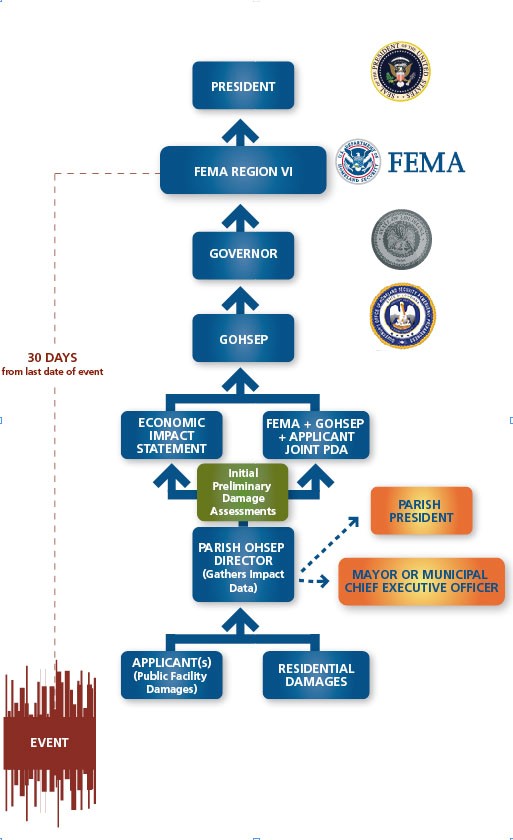Declaration Process
Municipal + Parish + Governor + Presidential

When an emergency or disaster event overwhelms State and local resources, the Governor can request Federal assistance through a Presidential declaration. The process is ground up.
- Damages have to be assessed.
- Damage indicators must be met.
- Local authorities have to declare a State of Emergency.
- The Governor has to request the Presidential declaration.
- FEMA Region VI has to approve it before it lands on the President’s desk.
Time is critical because the request must be made within 30 days from the date of the event.
The diagram to the right summarizes that process.
The Louisiana Homeland Security and Emergency Assistance and Disaster Act (Louisiana Disaster Act) – Louisiana Revised Statutes (LRS) Title 29:721 - 739 – provides the authority for the Governor, Parish Presidents and municipal chief executive officers to issue emergency declarations. Parish Presidents and Mayors can declare a State of Emergency in their respective jurisdictions. The Governor can declare a State of Emergency for any jurisdiction in the State or the State as a whole.
The occurrence of a disaster or emergency requires a response that creates issues not experienced in the everyday management of government. The emergency declaration grants the Governor and local officials in the declared area the authority to exercise extraordinary police powers to respond to the incident – powers they do not possess without the issuance of a properly executed emergency declaration.
Presidential Declaration
The Robert T. Stafford Disaster Relief and Emergency Assistance Act (Stafford Act) authorizes the President to issue an emergency or major disaster declaration, or both, for disasters that overwhelm the combined capabilities of State and local government resources.
Emergency Declaration
An emergency declaration addresses impending emergencies or disasters. It is issued when, in the determination of the President, Federal assistance is needed to supplement State and local efforts and capabilities to save lives and to protect property and public health and safety, or to lessen or avert the threat of a catastrophe.

Major Declaration
A major declaration is issued post-disaster when, in the determination of the President, damages are of sufficient severity and magnitude to warrant major disaster assistance to supplement the efforts and available resources of local governments, States, certain private nonprofit organizations (PNPs) – those that provide critical and essential governmental-type services – and individuals.
Major declarations open the door to the availability of disaster-related Stafford Act funding and technical assistance as well as Federal assistance under other authorities. A Stafford Act disaster declaration may also trigger Federal funding from other sources, such as U.S. Small Business Administration (SBA), U.S. Department of Agriculture (USDA) and U.S. Department of Housing and Urban Development (HUD), among others.
Assistance programs may include:
- FEMA Public Assistance (PA)
- FEMA Individual Assistance (IA)
- FEMA Hazard Mitigation Grant Program (HMGP)
- Direct Federal Assistance (DFA)
- Community loans
DFA comes through Mission Assignments from other Federal agencies.
The President can issue a major declaration and authorize assistance under the Stafford Act for either PA, Hazard Mitigation (HM) and/or IA. Other Federal agencies can issue an administrative or agency declaration under their own authority. For example, the SBA Administrator can declare an SBA-only declaration, which activates the SBA disaster loan program.
Expedited Declaration
An expedited declaration is a type of major declaration. It is issued when damages are so great or so apparent that a Preliminary Damage Assessment (PDA) is not required.
Process to Request a Presidential Declaration
As a pre-requisite to requesting a Presidential declaration, the Governor must first issue an emergency declaration for the State or disaster area, regarding the incident for which the request for the Presidential declaration is made.
After a state emergency declaration is made, the Governor makes the request for the Presidential disaster declaration by sending a letter to the President through the FEMA Regional Administrator (RA). The letter must state that:
- The Governor certifies the event has overwhelmed State and local resources.
- Federal assistance is required.
- Governor has issued a State of Emergency.
- Governor has directed the execution of the State of Louisiana Emergency Operations Plan (EOP).
There is other information required in the request to the President. The importance of this information cannot be overstated. Its quality, quantity and presentation determine the success or failure of the Governor’s request to the President. Most of this information is provided by Parish emergency management officials to the GOHSEP and includes:

Preliminary Damage Assessment (PDA)
A PDA is a joint assessment by FEMA, State and Subrecipient (Applicant). It is used to determine the magnitude and impact of an event’s damage and is the basis for a Presidential declaration decision.
Upon the arrival of the State/FEMA PDA Team, the Parish should have a complete list of all damaged structures throughout the Parish that are eligible for FEMA funding.
The PA declaration process considers impacts to public services infrastructure.
Damage to all infrastructure owned by local government entities and that are owned by certain PNPs – those that provide critical and essential governmental-type services are eligible for funding under the FEMA PA program to restore and repair those facilities when a declaration is made.
A major milestone in determining if the President will provide for PA funding in the declaration is whether the Parish has reached its monetary damage indicator published by FEMA. Annually, FEMA publishes a per capita dollar amount that is multiplied by the number of residents living in each Parish and the State using the latest U.S. Census data.
A two (2) prong test must be met:
- Each Parish must meet its level of damages or “damage indicator” to qualify to be included in the declaration.
- The State as a whole must meet a damage indicator of $6.3 million (FY2015).
For a more detailed discussion of the PDA process, visit the Preliminary Damage Assessment page of this website.
Information of importance for the Economic Impact Statement to be provided by the Parish emergency management officials includes:
Economic Impact Statement
In addition to the information in the damage assessment, FEMA also requires an Economic Impact Statement as part of the Governor’s request for a Presidential declaration. While the statement focuses on the economic impact of the event to the State, the information relied upon must come from the Parish level. The better the information each Parish provides to GOHSEP regarding the economic impact the event had on that Parish, the better the product the Governor presents to the President, and subsequently, the better chance the State has to be granted the declaration.
- List of businesses affected and how.
- Cascading effects of damage to infrastructure. (For example, do not just report that a road is out. If the road is a major commercial thoroughfare in a community, what are the consequences?)
- Number of persons out of work and for how long.
- Number of persons displaced and for how long.
- Anticipated effects on individual incomes.
- Anticipated effects of the above on the Parish tax base.
- How many and how long schools are expected to be closed.
- Extent of utilities outages and for how long.
- Any other pertinent information that contributes to the economic impact of the disaster.
- All deaths and injuries, as a result of the incident, should also be reported.
Declaration Flow Chart






